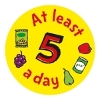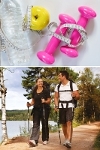Healthy Lifestyle Tips
This page contains helpful information for adults, children and families on living a healthy and active lifestyle.

Contents
Balanced Eating

The Eatwell Guide shows that different amounts of each food group we should have to form a healthy balanced diet. We don't need to have all of the food groups at every single meal but should aim to achieve this balance over a whole day.
Healthy lifestyle on a budget

Follow these top tips to eat well on a budget:
- Cook from scratch
- Cut down the amount of meat bought
- Buy own-brand goods
- Buy and cook in bulk
- Buy frozen fruits and vegetables
- Plan your meals and stick to the list
- Beware of offers
- Compare prices and know how much you can spend
- Buy in season
Portion Size
Eating the right amount of food goes hand in hand with having a balanced diet, we should aim to adjust portion sizes to each individual family member to ensure they have the correct amount; depending on the person's age, size and activity level. Using their hand acts as a great portion guide!
Curl for Cards  This means we should have a handful of carbohydrate foods. Such as pasta, rice, cereal, bread and noodles. | Palm for Protein  This means the size of protein foods should be the same as the palm of our hand. Such as chicken, fish, beef, tofu and beans. |
Fist for Fruit  A portion of fruit is the same size as our fist. Such as an apple, a small bunch of grapes or 2 satsumas. | Both for a portion of vegetables  A portion of vegetables is the same as our hands held together. Such as salad, carrots and broccoli. |
5 a day

Fruits and vegetables are high in vitamins, minerals and fibre, we should aim to get at least 5 portions per day, making up 1/3 of our diet. Enjoy as a snack and with meals!
Top Tips:
- Try steaming rather than boiling vegetables to preserve nutrients
- Add extra vegetables to meals such as bolognese and stews
- Choose fruit canned in juice rather than syrup
- Limit dried fruit to 1 small handful per day
- Fruit juice is higher in sugar and lower in fibre than whole fruit, for children dilute 50:50 with water
- Make smoothies from frozen fruit and add vegetables such as spinach to cut down on sugar
- Save money by choosing fruit and vegetables that are in season
For more information visit: https://www.nhs.uk/live-well/eat-well/5-a-day/5-a-day-what-counts/
Fat

There is often lots of confusion over which oil is the healthiest, which should we cook with and how much we should have.
When thinking about fats, it is first important to understand that there are different types.
- Monounsaturated - Have these in small amounts as they can help to maintain healthy cholesterol levels.
- Polyunsaturated - Have these in small amounts; Polyunsaturated fats help to maintain healthy cholesterol levels and provide essential fatty acids.
- Saturated - Eating too much saturated fat increases the amount of cholesterol in your blood.
- Trans - Avoid wherever possible. They can increase cholesterol in your blood.
Sugar

It is well understood that as a nation we are eating too much sugar.
But how much should we be having and how can we reduce our intake?
First of all, it's important to understand that there are different types of sugar.
- Free sugar = the sugar added to foods by the manufacturer, cook or consumer, plus sugars naturally present in honey, syrups and unsweetened fruit juices and smoothies.
- Naturally Occurring Sugar = sugars found naturally within milk and the sugars contained within the cellular structure of foods (particularly fruits and vegetables which have not been blended).
Label Reading
Often food packaging and advertising can be misleading; making us think a food or drink is better for us than it really is. By looking at a food label you choose between products and keep a check on the amount of foods you're eating that are high in fat, salt and added sugars.
How to use the label reading card:
- Locate the nutritional information on the back of the packet
- Look at the per 100g column
- This step is important as the card will not work if you use the per portion column
- Using sugar as an example
- Find "Carbohydrates - of which sugars"
- Ensure you are looking at the amount per 100g
- Check sugar amounts of traffic light card

Red means the food is high in something we should be trying to cut down on. Try to eat these foods as a treat & in smaller amounts.

Amber means the food is an OK choice most of the time and in the middle for that nutrient. Try to choose green where possible.

Green means the food is low in salt, saturated fat, fat or sugars. The more green lights, the healthier the choice!
Snacking
The first thing many people do when they want to eat more healthily is stop snacking. However, snacks form an important part of a healthy and balanced diet, choosing the right ones is key!
Health snacks keep us full between meals, give us energy, control our hunger and are a source of nutrients.

We should limit snacks that:
- Do not keep you full up so you will be hungry more quickly and are more likely to overeat
- Contain 'empty calories' as they provide no/ low levels of nutrients
- Contain high levels fat, salt and sugar
We should choose snacks which:
- Keep us full as they contain more fibre
- Are high in nutrients such as vitamins, minerals and fibre
- Are less processed
- Do not contain as much added sugar, fat, salt, preservatives
Packed lunches
Lunch contributes to around 1/3 of our intake, therefore it is important that it contains good sources of vitamins, minerals, carbohydrate, dairy, protein and fibre. Your child could be entitled to a Free School Meal. These lunches provide children and young people with a nutritionally balanced meal and can contribute to their 5 a day.

Packed lunches can often be higher in fat, sugar and salt and can contain more processed foods.
Try including:
- Starchy foods - these include bread, rice, potatoes and pasta
- Protein foods - including meat, fish, eggs, beans
- A dairy item - this could be cheese or a natural low fat yoghurt
- Vegetables or salad and a portion of fruit
- Water
Try not to include:
- Confectionery such as sweets and chocolate
- Crisps and biscuits
- Processed meat products such as sausage rolls, scotch eggs and pork pies
- Fizzy or sugary drinks
Eating out & Takeaways
Larger portion sizes and foods higher in fat, sugar and salt. It's no surprise that regular takeaways & meals out can lead to weight gain. Check out the best options below!
Italian
Avoid:
- Large and deep dish pizzas, pizzas with cheese stuff crust
- Triple cheese and pepperoni pizzas
- Creamy pasta sauces such a carbonara
- Garlic bread
Choose:
- Small or medium pizza with a thin base
- Vegetable or lean meat toppings
- Tomato-based pasta sauces such as Pomodoro or Arrabbiata
- Bruschetta
Chinese
Avoid:
- Sweet and sour
- Crispy fried beef
- Battered pork/chicken balls
- Special or egg fried rice
- Prawn toast and spring rolls
Choose:
- Crab and corn soup
- Steamed dumplings, steamed vegetables and plain boiled rice
- Steamed fish, chicken and chop suey
- Szechuan prawns
Indian
Avoid:
- Creamy curries such a korma, passanda or masala
- Nann, bhajis, pakoras and poppadoms.
Choose:
- Tandoori or madras with chicken, prawns or vegetables
- Plain rice & Chapatti
Burgers & Kebabs
Avoid:
- Doner kebab
- Added cheese & mayonnaise
- Thin-cut chips
- Chicken or fish deep fried in batter
Choose:
- Shish kebab with pitta bread and salad
- Grilled burgers made from lean fish, beef or chicken
Alcohol
Alcohol is very high in empty calories and can lead to us eating foods high in fat, sugar and salt when we drink it. Check out the amount of alcohol and calories in your favourite drink below and our tips on how to reduce your intake!
- 1 Pint of Guinness = 2.3 units - 4% = 210—250 calories
- 250ml Glass of Wine = 2.8—3.5 units - 11% - 14% = 165 - 235 calories
- 1 Pint of Cider = 2.8 units - 5% = 200—250 calories
- 275ml bottle of Alcopop = 1.1 units - 4% = 170 calories
- 1 Pint of Lager = 2.8 units - 5% = 180—250 calories
- 25 ml measure of spirit = 1 unit = 65 calories
Alternate between alcoholic and non-alcoholic drinks throughout the night, not only will this save you money but you will cut your calorie intake in half and help reduce the risk of intoxication (getting drunk quickly).
Dilute alcoholic drinks such as wine and beer with low calorie mixers to make a spritzer or shandy.
Try a lower calorie alcohol, spirits such as vodka are lower in calories than beer and wine.
Remember alcohol can stimulate your appetite and makes you less likely to make healthy food choices.
Avoid the kebab shop on the walk home by preparing a healthy snack before you go out, this will also help to stop you feeling drunk quickly.
Healthy Weight
Find out more about Body Mass Index (BMI), what is it and what does your result mean?
What is BMI?
- Adults: BMI is a measure that uses your height and weight to work out if your weight is healthy.
- For children and young people aged 2 to 17: The BMI calculation takes into account age and gender as well as height and weight.
How can I work out my BMI?
For both adults and children: You can use the NHS choices BMI calculator online.
Physical Activity for Adults

There are a range of health and social benefits associated with physical activity, however the vast majority of people are not active enough!
Find an activity that you enjoy doing and make it part of your normal, everyday life.
This way you are much more likely to stay active long term which is key to living a healthy lifestyle and reducing your risk of obesity, poor mobility and various diseases.
Physical Activity for Children
Children aged over 5 should be physically active for at least 60 minutes each day!
Top Tips to Increase exercise as a family:
- Try new activities that you can do as a family, swimming can be great fun for everyone
- Remember children do not always do as much exercise at school as what we think they do
- Make the most of the great outdoors going for a walk or a trip to the park
- Set by example and try to be a role model for your family
- Swap screen time for active time
Active travel:
- Travel as much as you can in an active way, this can contribute to children's physical activity goal of 60 minutes per day.
- This includes walking, cycling or scooting to school or to the shops
- If you have to drive, simply park further away and walk the last part. You'll avoid traffic and burn energy at the same time
- Stand on the train or bus, take the stairs and walk up escalators
- Try to move around every 20 minutes and reduce the amount of time spent sitting down
- Getting children active when they are young, encourages good activity patterns and habits later in childhood
Mental Health
We all have mental health and every year 1 in 4 people are thought to experience mental health difficulties. It is good to understand how we can seek help for ourselves and others if experiencing mental health difficulties.
Anxiety:
Anxiety is a common but unpleasant feeling many of us will experience throughout our lives. People can experience anxiety about a range of things such as meeting new people and big life events such as moving house. While anxiety is a normal emotion, sometimes it can reach a level where it has a significant impact on a person's everyday life and may mean that they are not able to do or enjoy the things they want or need to do.
Depression:
It is not unusual for someone to feel low, sad or tearful sometimes, especially when something particularly upsetting has happened. Depression is a mental illness that makes a person feel sad or unable to enjoy life for a sustained period of time.
Support for anyone needing support with their mental health:
Contact your GP if you have noticed the changes in the way you are thinking or feeling over the past few weeks or months that concern you or cause distress (e.g. loss of appetite, feeling low or anxious, thinking negative thoughts about yourself, irritability, trouble sleeping, finding it hard to concentrate).
Other mental illnesses:
While anxiety disorders and depression are two of the most common types of mental health problems that people experience there are also many others, for example OCD, eating disorders and bipolar. Mental illnesses can be short term illnesses or can persist throughout a person's life. But, with the right treatment and support, people with mental health illnesses can live full and satisfying lives.
The Emotional Health Academy (EHA) Support Service:
We offer specific services directly to parents in and around West Berkshire to support their child or young person with their emotional needs. We carry out emotional health assessments and deliver evidenced based, low intensity talking therapies. Support is tailored to the needs of the individual and is offered where they feel comfortable and safe.
For information and access to local services for mental health support download our mental health guide to local services
5 Ways to Wellbeing
Evidence suggests there are five actions we can all take every day to improve our mental wellbeing. Give them a try, you may feel happier, more positive and able to get the most from life!

Connect with the people around you: your family, friends, colleagues and neighbours. Spend time developing these relationships.

You don't have to go to the gym. Take a walk, go cycling or play a game of football. Find an activity that you enjoy and make it a part of your life.

Learning new skills can give you a sense of achievement and a new confidence. So why not sign up for that cooking course, start learning to play a musical instrument, or figure out how to fix your bike?

Even the smallest act can count, whether it's a smile, a thank you or a kind word. Volunteering can improve your mental wellbeing and help you build new social networks.

Be more aware of the present moment, including your thoughts, feelings, your body and the world around you. Some people call this awareness "mindfulness". It can positively change the way you feel about life and how you approach challenges.

For more tips on how to improve your mental health and wellbeing :
Screen & Sedentary Time
The Royal College of Paediatrics and Child Health suggests that screentime limits in families should be negotiated based on the needs of each individual child and would recommend that everyone avoid screens an hour before bed as you need enough good quality sleep to play, learn and concentrate during the day.
Sleep
Sleep is incredibly important and should be seen as the foundation for a healthy lifestyle. Research shows that poor sleep can lead to a poor diet, active levels and mental health. 1 in 3 people struggle with a sleep disorder at some point in their life and below are some good tips to help make sure you are getting the sleep you need.
- Wind down before you sleep, relaxing and preparing to sleep around 90 minutes before you go to bed. This may include writing down any stresses for the day in a journal or meditating.
- Try to make sure your bedroom is a sleep friendly environment. Dark, cool (around 19 degrees) and comfortable.
- Avoid caffeine at least four hours before bed. Not only can it effect falling to sleep but also the quality of your sleep too.
- Keep yourself physically active during the day and don't over indulge in food or alcohol before bed.
Suicide Prevention
Help prevent a suicide, suicidal feelings could include:
Believing death is your only option, feeling helpless and worthless, feeling that things won't get better, feeling overwhelmed and unable to cope, feeling undecided about whether you want to live or die.
If someone is in crisis or has attempted suicide: if it's an emergency call 999 straight away and ask for an ambulance. Ring the Mental Health Crisis Team if you need urgent help, but it's not an emergency on 0300 365 0300.
Dementia
Dementia is a progressive condition that affects memory, thinking and behaviour. Below are some of the things that we can do that may reduce the risk of dementia.
You can find more information here: You can find more information here:
Alzheimer's Society Dementia
Support Line 0333 150 3456
Dementia UK
Helpline 0800 888 6678
Reducing your risk of dementia - Alzheimer's Research UK https://tinyurl.com/38cyvnx8
www.westberks.gov.uk/article/38994/Supporting-People-with-Dementia
Apps
Check out these great, FREE apps at an online Apps store to help you and your family live a healthy and active lifestyle.
My Fitness Pal
A great app for adults to keep track of your food intake, simply scan the barcode or look up the item in the app and it will log the calories and nutrients in your own personal food diary. Great for motivation, losing weight and keeping track of your food and activity level!
Sugar Smart
Get sugar smart with this new app from Change4Life! Simply scan the barcode of different foods and drinks to see how many cubes of sugar they contain. Use at home or in the supermarket, this app will help you to make healthier choices and cut down your sugar intake.
Easy Meals
Easy meals is filled with over a 150 easy, healthy recipes, detailing calories, ingredients and the methods to make them. With great ideas for breakfasts, lunch, dinner and puddings and the ability to save and send your favourite recipe at the touch of a button.
Sleepio
Sleepio is an evidence-based online sleep improvement programme for adults. Over six weeks you will learn tools and techniques based on cognitive behaviour therapy to help you fall asleep faster and stay asleep through the night. www.sleepio.com/nhs hello@sleepio.com
Better Health
NHS Better Health has a variety of apps to help you be healthier, starting with a quick quiz it gives advice on lifestyle changes. Apps include Easy Meals, Couch to 5k, Drink tracker and Stoptober.
Better Health Healthier Families
Would you or your family like to be healthier and happier? Would you like loads of ideas, recipes and games to help you do this? Then you already know why you Healthier Families
Useful Contacts

NHS
NHS Choices is the official website of the NHS, providing an award-winning, comprehensive health information service with thousands of articles, videos and tools, helping you to make the best choices about your health and lifestyle.
Our lifestyles can be more unhealthy than we think. Start the fight back to a healthier you. Take the One You quiz and see how you score.
Would you or your family like to be healthier and happier? Would you like loads of ideas, recipes and games to help you do this? Then you already know why you should join Change4Life.

Diabetes UK

British Heart Foundation

Emotional Health Academy
The Emotional Health Academy (EHA) IS West Berkshire's early emotional health service for children and young people. Opened in 2016, it works alongside services in the public and voluntary sector, including GPs and schools, to strengthen wellbeing and resilience in children, young people and families.

Smoke Free Life Berkshire
A free 12 week stop smoking programme offering free NRT and behavioural support.

West Berkshire Council
The Public Health & Wellbeing Service - committed to improving the health and wellbeing of the population across the district.
Activity for Health Referral Programme
A programme of exercise, available on referral by your GP, at Legacy Leisure Centres.

Run Together
If you're new to running, or just out of practice, there are a number of running groups especially for beginners in West Berkshire to help you get off on the right foot.

Wellbeing Walks
Free regular, led, health walks ranging from 30 - 90 minutes.

Via
Worried about your own or someone else's alcohol or drug use? We offer free and confidential advice, support and treatment for people in West Berkshire.
Safe Sex Berkshire
The specialist Clinics' provide a free confidential sexual health service across Berkshire.
Download
To download a copy of the above content and much more in an accessible PDF format, please click the link below.




